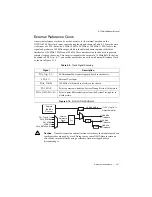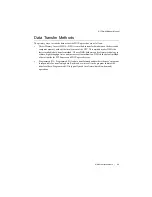
© National Instruments
|
2-11
AI Sample Clock Signal
Use the AI Sample Clock (ai/SampleClock) signal to initiate a set of measurements. Your
NI PXIe-4300 module samples the AI signals of every channel in the task once for every
AI Sample Clock. A measurement acquisition consists of one or more samples.
You can specify an internal or external source for AI Sample Clock. You also can specify
whether the measurement sample begins on the rising edge or falling edge of AI Sample Clock.
Using an Internal Source
One of the following internal signals can drive AI Sample Clock:
•
AI Sample Clock Timebase (divided down).
•
A pulse initiated by host software that does a software,
on demand
, acquisition.
A programmable internal counter divides down the sample clock timebase.
Several other internal signals can be routed to AI Sample Clock through internal routes. Refer
to
Device Routing in MAX
in the
NI-DAQmx Help
or the
LabVIEW Help
for more information.
Using an External Source
Use one of the following external signals as the source of AI Sample Clock:
•
PFI <0, 1>
•
PXI_Trig <0..7>
•
PXI_STAR
•
PXIe_DSTAR <A, B>
Routing AI Sample Clock Signal to an Output Terminal
You can route AI Sample Clock out to any PXI_Trig <0..7>, or PXIe_DSTARC terminal. This
pulse is always active high.
All PFI terminals are configured as inputs by default.
Other Timing Requirements
Your DAQ device only acquires data during an acquisition. The device ignores AI Sample Clock
when a measurement acquisition is not in progress. During a measurement acquisition, you can
cause your DAQ device to ignore AI Sample Clock using the AI Pause Trigger signal.
A counter/timing engine on your device internally generates AI Sample Clock unless you select
some external source. AI Start Trigger starts this counter and either software or hardware can
stop it once a finite acquisition completes. When using an internally generated AI Sample Clock,
you also can specify a configurable delay from AI Start Trigger to the first AI Sample Clock
pulse. By default, this delay is set to two ticks of the AI Sample Clock Timebase signal.
















































